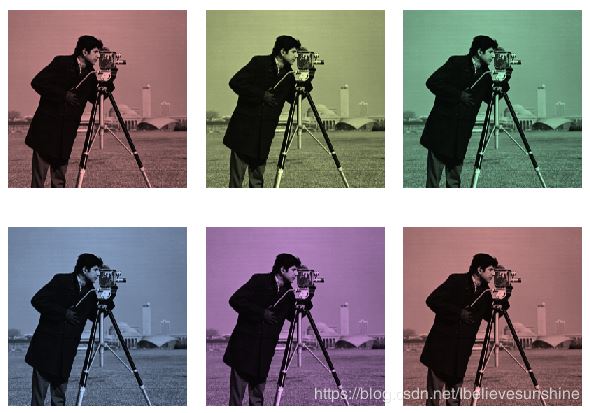python库skimage给灰度图像染色的方法示例
灰度图像染成红色和黄色
# 1.将灰度图像转换为RGB图像image = color.gray2rgb(grayscale_image)# 2.保留红色分量和黄色分量red_multiplier = [1, 0, 0]yellow_multiplier = [1, 1, 0]# 3.显示图像fig, (ax1, ax2) = plt.subplots(ncols=2, figsize=(8, 4),sharex=True, sharey=True)ax1.imshow(red_multiplier * image)ax2.imshow(yellow_multiplier * image)

HSV图像,H从0到1表示的颜色
hue_gradient = np.linspace(0, 1)# print(hue_gradient.shape) # output:(50,)hsv = np.ones(shape=(1, len(hue_gradient), 3), dtype=float)hsv[:, :, 0] = hue_gradientall_hues = color.hsv2rgb(hsv)fig, ax = plt.subplots(figsize=(5, 2))# Set image extent so hues go from 0 to 1 and the image is a nice aspect ratio.ax.imshow(all_hues, extent=(0, 1, 0, 0.2))ax.set_axis_off()

将灰度图像染成不同的颜色
hue_rotations = np.linspace(0, 1, 6)fig, axes = plt.subplots(nrows=2, ncols=3, sharex=True, sharey=True)for ax, hue in zip(axes.flat, hue_rotations): # Turn down the saturation to give it that vintage look. tinted_image = colorize(image, hue, saturation=0.3) ax.imshow(tinted_image, vmin=0, vmax=1) ax.set_axis_off()fig.tight_layout()

完整代码
'''=========================Tinting gray-scale images=========================It can be useful to artificially tint an image with some color, either tohighlight particular regions of an image or maybe just to liven up a grayscaleimage. This example demonstrates image-tinting by scaling RGB values and byadjusting colors in the HSV color-space.In 2D, color images are often represented in RGB---3 layers of 2D arrays, wherethe 3 layers represent (R)ed, (G)reen and (B)lue channels of the image. Thesimplest way of getting a tinted image is to set each RGB channel to thegrayscale image scaled by a different multiplier for each channel. For example,multiplying the green and blue channels by 0 leaves only the red channel andproduces a bright red image. Similarly, zeroing-out the blue channel leavesonly the red and green channels, which combine to form yellow.'''import matplotlib.pyplot as pltfrom skimage import datafrom skimage import colorfrom skimage import img_as_floatgrayscale_image = img_as_float(data.camera()[::2, ::2])image = color.gray2rgb(grayscale_image)red_multiplier = [1, 0, 0]yellow_multiplier = [1, 1, 0]fig, (ax1, ax2) = plt.subplots(ncols=2, figsize=(8, 4),sharex=True, sharey=True)ax1.imshow(red_multiplier * image)ax2.imshow(yellow_multiplier * image)####################################################################### In many cases, dealing with RGB values may not be ideal. Because of that,# there are many other `color spaces`_ in which you can represent a color# image. One popular color space is called HSV, which represents hue (~the# color), saturation (~colorfulness), and value (~brightness). For example, a# color (hue) might be green, but its saturation is how intense that green is# ---where olive is on the low end and neon on the high end.## In some implementations, the hue in HSV goes from 0 to 360, since hues wrap# around in a circle. In scikit-image, however, hues are float values from 0# to 1, so that hue, saturation, and value all share the same scale.## .. _color spaces:# https://en.wikipedia.org/wiki/List_of_color_spaces_and_their_uses## Below, we plot a linear gradient in the hue, with the saturation and value# turned all the way up:import numpy as nphue_gradient = np.linspace(0, 1)# print(hue_gradient.shape) # output:(50,)hsv = np.ones(shape=(1, len(hue_gradient), 3), dtype=float)hsv[:, :, 0] = hue_gradientall_hues = color.hsv2rgb(hsv)fig, ax = plt.subplots(figsize=(5, 2))# Set image extent so hues go from 0 to 1 and the image is a nice aspect ratio.ax.imshow(all_hues, extent=(0, 1, 0, 0.2))ax.set_axis_off()####################################################################### Notice how the colors at the far left and far right are the same. That# reflects the fact that the hues wrap around like the color wheel (see HSV_# for more info).## .. _HSV: https://en.wikipedia.org/wiki/HSL_and_HSV## Now, let’s create a little utility function to take an RGB image and:## 1. Transform the RGB image to HSV 2. Set the hue and saturation 3.# Transform the HSV image back to RGBdef colorize(image, hue, saturation=1): ''' Add color of the given hue to an RGB image. By default, set the saturation to 1 so that the colors pop! ''' hsv = color.rgb2hsv(image) hsv[:, :, 1] = saturation hsv[:, :, 0] = hue return color.hsv2rgb(hsv)####################################################################### Notice that we need to bump up the saturation; images with zero saturation# are grayscale, so we need to a non-zero value to actually see the color# we’ve set.## Using the function above, we plot six images with a linear gradient in the# hue and a non-zero saturation:hue_rotations = np.linspace(0, 1, 6)fig, axes = plt.subplots(nrows=2, ncols=3, sharex=True, sharey=True)for ax, hue in zip(axes.flat, hue_rotations): # Turn down the saturation to give it that vintage look. tinted_image = colorize(image, hue, saturation=0.3) ax.imshow(tinted_image, vmin=0, vmax=1) ax.set_axis_off()fig.tight_layout()####################################################################### You can combine this tinting effect with numpy slicing and fancy-indexing# to selectively tint your images. In the example below, we set the hue of# some rectangles using slicing and scale the RGB values of some pixels found# by thresholding. In practice, you might want to define a region for tinting# based on segmentation results or blob detection methods.from skimage.filters import rank# Square regions defined as slices over the first two dimensions.top_left = (slice(100),) * 2bottom_right = (slice(-100, None),) * 2sliced_image = image.copy()sliced_image[top_left] = colorize(image[top_left], 0.82, saturation=0.5)sliced_image[bottom_right] = colorize(image[bottom_right], 0.5, saturation=0.5)# Create a mask selecting regions with interesting texture.noisy = rank.entropy(grayscale_image, np.ones((9, 9)))textured_regions = noisy > 4# Note that using `colorize` here is a bit more difficult, since `rgb2hsv`# expects an RGB image (height x width x channel), but fancy-indexing returns# a set of RGB pixels (# pixels x channel).masked_image = image.copy()masked_image[textured_regions, :] *= red_multiplierfig, (ax1, ax2) = plt.subplots(ncols=2, nrows=1, figsize=(8, 4),sharex=True, sharey=True)ax1.imshow(sliced_image)ax2.imshow(masked_image)plt.show()####################################################################### For coloring multiple regions, you may also be interested in# `skimage.color.label2rgb http://scikit-# image.org/docs/0.9.x/api/skimage.color.html#label2rgb`_.

到此这篇关于python库skimage给灰度图像染色的方法示例的文章就介绍到这了,更多相关python 灰度图像染色内容请搜索好吧啦网以前的文章或继续浏览下面的相关文章希望大家以后多多支持好吧啦网!
相关文章:
1. Docker+nacos+seata1.3.0安装与使用配置教程2. Django中的AutoField字段使用3. Java Idea TranslationPlugin翻译插件使用解析4. Python+Appium实现自动化测试的使用步骤5. Java智能卡基础篇——未来Java平台的新发展6. Django ORM filter() 的运用详解7. Java基础之详解HashSet的使用方法8. 快速解决Django关闭Debug模式无法加载media图片与static静态文件9. javascript使用alert实现一个精美的弹窗10. Java8中用foreach循环获取对象的index下标详解

 网公网安备
网公网安备